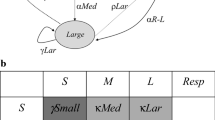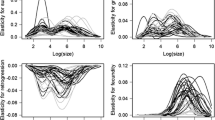Abstract
It is at the population level that an invasion either fails or succeeds. Lantana camara L. (Verbenaceae) is a weed of great significance in Queensland Australia and globally but its whole life-history ecology is poorly known. Here we used 3 years of field data across four land use types (farm, hoop pine plantation and two open eucalyptus forests, including one with a triennial fire regime) to parameterise the weed’s vital rates and develop size-structured matrix models. Lantana camara in its re-colonization phase, as observed in the recently cleared hoop pine plantation, was projected to increase more rapidly (annual growth rate, λ = 3.80) than at the other three sites (λ 1.88–2.71). Elasticity analyses indicated that growth contributed more (64.6 %) to λ than fecundity (18.5 %) or survival (15.5 %), while across size groups, the contribution was of the order: juvenile (19–27 %) ≥ seed (17–28 %) ≥ seedling (16–25 %) > small adult (4–26 %) ≥ medium adult (7–20 %) > large adult (0–20 %). From a control perspective it is difficult to determine a single weak point in the life cycle of lantana that might be exploited to reduce growth below a sustaining rate. The triennial fire regime applied did not alter the population elasticity structure nor resulted in local control of the weed. However, simulations showed that, except for the farm population, periodic burning could work within 4–10 years for control of the weed, but fire frequency should increase to at least once every 2 years. For the farm, site-specific control may be achieved by 15 years if the biennial fire frequency is tempered with increased burning intensity.





Similar content being viewed by others
References
Akçakaya HR (2005) RAMAS GIS: linking spatial data with population viability analysis. Applied biomathematics Inc. Setauket, New York
Babu S, Love A, Babu CR (2009) Ecological restoration of lantana-invaded landscapes in Corbett Tiger Reserve, India. Ecol Restor 27:467–477
Bierzychudek P (1982) The demography of jack-in-the-pulpit, a forest perennial that changes sex. Ecol Monogr 52:335–351
Caplat P, Nathan R, Buckley YM (2012) Seed terminal velocity, wind turbulence, and demography drive the spread of an invasive tree in an analytical model. Ecology 93:368–377
Caswell H (1989) Matrix population models: construction, analysis, and interpretation. Sinauer Associates, Massachusetts
Caswell H (2000) Prospective and retrospective perturbation analyses: their roles in conservation biology. Ecology 81:619–627
Colautti RI, Bailey SA, van Overdijk CDA, Amundsen K, MacIsaac HJ (2006) Characterised and projected costs of nonindigenous species in Canada. Biol Invasions 8:45–59
D’Antonio CM (2000) Fire, plant invasions, and global changes. In: Mooney HA, Hobbs RJ (eds) Invasive species in a changing world. Island Press, Washington, DC, pp 65–94
Davis AS, Landis DA, Nuzzo V, Blossey B, Gerber E, Hinz HL (2006) Demographic models inform selection of biocontrol agents for garlic mustard (Alliaria petiolata). Ecol Appl 16:2399–2410
Day MD, Wiley CJ, Playford J, Zalucki MP (2003) Lantana: current management status and future prospects. ACIAR monograph series 102, Canberra, Australia
DeWalt SJ (2006) Population dynamics and potential for biological control of an exotic invasive shrub in Hawaiian rainforests. Biol Invasions 8:1145–1158
DiTomaso JM (2006) Control of invasive plants with prescribed fire. In: DiTomaso JM, Johnson DW (eds) The use of fire as a tool in controlling invasive plants. Cal-IPC Publication 2006-1, California Invasive Plant Council, Berkeley, pp 7–18
Doren RF, Whiteaker LD (1990) Effects of fire on different size individuals of Schinus terebinthifolius. Nat Area J 10:107–113
Duggin JA, Gentle CB (1998) Experimental evidence on the importance of disturbance intensity for invasion of Lantana camara L. in dry rainforest-open forest ecotones in north-eastern NSW, Australia. For Ecol Manag 109:279–292
Emery SA, Gross KL (2005) Effects of timing of prescribed fire on the demography of an invasive plant, spotted knapweed Centaurea maculosa. J Appl Ecol 42:60–69
Ezard THG, Bullock JM, Dalgleish HJ, Millon A, Pelletier F, Ozgul A, Koons DN (2010) Matrix models for a changeable world: the importance of transient dynamics in population management. J Appl Ecol 47:515–523
Fensham RJ, Fairfax RJ, Connell RJ (1994) The invasion of Lantana camara L. in Forty Mile Scrub National Park, North Qld. Aust J Ecol 19:297–305
Fox GA, Gurevitch J (2000) Population numbers count: tools for near-term demographic analysis. Am Nat 156:242–256
Garnier LKM, Dajoz I (2001) The influence of fire on the demography of a dominant grass species of West African savannas, Hyparrhenia diplandra. J Ecol 89:200–208
Gentle CB, Duggin JA (1997) Allelopathy as a competitive strategy in persistent thickets of Lantana camara L. in three Australian forest communities. Plant Ecol 132:85–95
Gooden B, French K, Turner PJ (2009) Invasion and management of a woody plant, Lantana camara L., alters vegetation diversity within wet sclerophyll forest in southeastern Australia. For Ecol Manag 257:960–967
Gross K, Lockwood JR, Frost CC, Morris WF (1998) Modeling controlled burning and trampling reduction for conservation of Hudsonia montana. Conserv Biol 12:1291–1301
Hiremath AJ, Sundaram B (2005) The fire-lantana cycle hypothesis in Indian forests. Conserv Soc 3:26–42
Kelly D, Ladley JJ, Robertson AW, Anderson SH, Wotton DM, Wiser SK (2010) Mutualisms with the wreckage of an avifauna: the status of bird pollination and fruit-dispersal in New Zealand. N Z J Ecol 34:66–85
Kettenring KM, Adams CR (2011) Lessons learned from invasive plant control experiments: a systematic review and meta-analysis. J Appl Ecol 48:970–979
Lesica P, Ellis M (2010) Demography of sulfur cinquefoil (Potentilla recta) in a Northern Rocky Mountain grassland. Invasive Plant Sci Manag 3:139–147
Lowe S, Browne M, Boudjelas S, De-Poorter M (2004) One hundred of the world’s worst invasive alien species: a selection from the global invasive species database. Invasive Species Specialist Group, IUCN, Switzerland
Mack RN, Simberloff D, Lonsdale MW, Evans H, Clout M, Fakhri FA (2000) Biotic invasions: causes, epidemiology, global consequences and control. Ecol Appl 10:689–710
Masocha M, Skidmore AK, Poshiwa X, Prins HHT (2011) Frequent burning promotes invasions of alien plants into a mesic African savanna. Biol Invasions 13:1641–1648
Menges ES, Quintana-Ascencio PF (2004) Population Viability with fire in Eryngium cuneifolium: deciphering a decade of demographic data. Ecol Monogr 74:79–99
Nehrbrass N, Winkler E, Pergl J, Perglova I, Pyšek P (2006) Empirical and virtual investigation of the population dynamics of an alien plant under the constraints of local carrying capacity: Heracleum mantegazzianum in the Czech Republic. Perspect Plant Ecol 7:253–262
Osunkoya OO, Perrett C (2011) Lantana camara L. (Verbenaceae) invasion effects on soil physicochemical properties. Biol Fertil Soils 47:349–355
Osunkoya OO, Perrett C, Fernando C (2010) Population viability analysis models for Lantana camara L. (Verbenaceae): a weed of national significance. In: Zydenbos SM (ed) Proceedings of the 17th Australasian weeds conference. New Zealand Plant Protection Society, Christchurch, pp 91–94
Osunkoya OO, Perrett C, Fernando C, Clark C, Raghu S (2012) Stand dynamics and spatial pattern across varying land uses in the invasive Lantana camara L. (Verbenaceae). Plant Ecol 213:883–897
Parker IM (2000) Invasion dynamics of Cytisus scoparius: a matrix model approach. Ecol Appl 10:726–743
Pimentel D, McNair S, Janecka J, Wightman J, Simmonds C, O’Connell C, Wong E, Russel L, Zern J, Aquino T, Tsomondo T (2001) Economic and environmental threats of alien plant, animal, and microbe invasions. Agric Ecosyst Environ 84:1–20
Raghu S, Wilson JR, Dhileepan K (2006) Refining the process of agent selection through understanding plant demography and plant response to herbivory. Aust J Entomol 45:308–316
Raizada P, Raghubanshi A (2010) Seed germination behaviour of Lantana camara in response to smoke. Trop Ecol 51(2S):347–352
Ramula S, Knight TM, Burns JH, Buckley YM (2008) General guidelines for invasive plant management based on comparative demography of invasive and native plant populations. J Appl Ecol 45:1124–1133
Richards CL, Bossdorf O, Muth NZ, Gurevitch J, Pigliucci M (2006) Jack of all trades, master of some? On the role of phenotypic plasticity in plant invasions. Ecol Lett 9:981–993
Schutzenhofer MR, Valone TJ, Knight TM (2009) Herbivory and population dynamics of invasive and native Lespedeza. Oecologia 161:57–66
Sebert-Cuvillier E, Paccaut F, Chabrerie O, Endels P, Goubet O, Decocq G (2007) Local population dynamics of an invasive tree species with a complex life-history cycle: a stochastic matrix model. Ecol Model 201:127–143
Sharma G, Raghubanshi A (2006) Tree population structure, regeneration and expected future composition at different levels of Lantana camara L. invasion in the Vindhyan tropical dry deciduous forest of India. Lyonia 11:27–39
Sharma GP, Raghubanshi AS, Singh JS (2005) Lantana invasion: an overview. Weed Biol Manag 5:157–165
Shea K, Kelly D (1998) Estimating biocontrol agent impact with matrix models: Carduus nutans in New Zealand. Ecol Appl 8:824–832
Shea K, Kelly D, Sheppard AW, Woodburn TL (2005) Context-dependent biological control of an invasive thistle. Ecology 86:3174–3181
Silva JF, Raventos J, Caswell H, Trevisan MC (1991) Population responses to fire in a tropical savanna grass, Andropogon semiberbis: a matrix model approach. J Ecol 79:345–356
Stevens JT, Beckage B (2010) Fire effects on demography of the invasive shrub Brazilian Pepper (Schinus terebinthifolius) in Florida Pine Savannas. Nat Areas J 30:53–63
Stott I, Franco M, Carslake D, Townley S, Hodgson D (2010) Boom or bust? A comparative analysis of transient population dynamics in plants. J Ecol 98:302–311
Vivian-Smith G, Panetta FD (2009) Lantana (Lantana camara seed bank dynamics: seedling emergence and seed survival. Invasive Plant Sci Manag 2:141–150
Vivian-Smith G, Gosper CR, Wilson A, Hoad K (2006) Lantana camara and the fruit- and seed-damaging fly, Ophiomyia lantanae (Agromyzidae): seed predator, recruitment promoter or dispersal disrupter? Biol Control 36:247–257
Zalucki MP, Day MD, Playford J (2007) Will biological control of Lantana camara ever succeed? Patterns, processes and prospects. Biol Control 42:251–261
Acknowledgments
We thank Roger Anderson of Forestry Plantation Queensland (Australia) for providing much needed logistic support and access to numerous hoop pine plantation and eucalyptus forests under FPQ jurisdiction. Thanks also to Glen Douglass for access and use of his cattle farm to document long-term demographic changes of the invasive lantana in abandoned primary production lands. Many volunteers over the years helped in collection of the field data, especially Amanda Dimmock, Matthew Shortus, Jayd McCarthy and Stephen Caruana. The research was funded by the Queensland government through the Land Protection Council and by the Australian Federal Government through its Weeds of National Significance (WONS) program for Lantana camara. The input of Dr Dane Panetta in reading various versions of the manuscript is acknowledged.
Author information
Authors and Affiliations
Corresponding author
Electronic supplementary material
Below is the link to the electronic supplementary material.
Rights and permissions
About this article
Cite this article
Osunkoya, O.O., Perrett, C., Fernando, C. et al. Modeling population growth and site specific control of the invasive Lantana camara L. (Verbenaceae) under differing fire regimes. Popul Ecol 55, 291–303 (2013). https://doi.org/10.1007/s10144-013-0364-7
Received:
Accepted:
Published:
Issue Date:
DOI: https://doi.org/10.1007/s10144-013-0364-7




